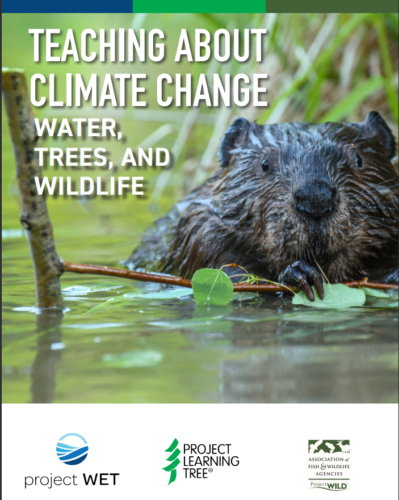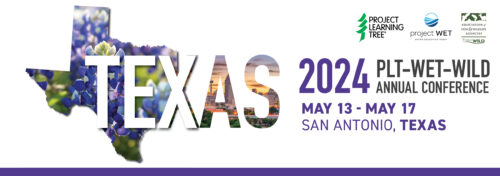Climate change is a complex topic that can be intimidating to teach. However, understanding climate, including the ways it is changing and how that impacts the environment, is crucial to making informed decisions and building resilience. Project Learning Tree, Project WET, and Project WILD provide over 100 hands-on activities that are grounded in each of our environmental focuses.
 Check out the Teaching About Climate Change: Water, Trees and Wildlife PDF to help plan a lesson series that fits your setting and audience about the impacts of climate change on water, forests and biodiversity. These climate-focused activities provide your students with engaging educational experiences that will help them understand climate literacy and resilience for communities and the environment. We hope these lessons will inspire you and your students to develop innovative solutions to address challenges that are arising as a result of climate change.
Check out the Teaching About Climate Change: Water, Trees and Wildlife PDF to help plan a lesson series that fits your setting and audience about the impacts of climate change on water, forests and biodiversity. These climate-focused activities provide your students with engaging educational experiences that will help them understand climate literacy and resilience for communities and the environment. We hope these lessons will inspire you and your students to develop innovative solutions to address challenges that are arising as a result of climate change.
Hands-on Activities
Project Learning Tree’s award-winning environmental education program is designed for teachers and other educators, parents, and community leaders working with youth from preschool through grade 12. PLT provides educators with tools, training, resources, and a support network of other non-formal and formal educators seeking to integrate outdoor education into their curriculum. PLT seeks to bring the environment into the classroom, and students into the environment. The materials are multi-disciplinary and aligned with state and national education standards.
Example PLT Climate activities:
- Living with Fire – Students learn about the three elements a fire needs to burn and find out how an understanding of this “fire triangle” can be used to both prevent and manage wildland fires. They could also focus on the impact of climate change on the frequency of wildland fires. You can find this activity in PLT’s Explore Your Environment: K-8 Activity Guide and our Nature of Fire digital activity collection.
- Monitoring Forest Health – Through a variety of health indicators, learners assess the health of a forested area, and see how soil scientists, wildlife biologists, arborists, and other forest professionals monitor forests. They could focus their assessment on climate change effects. You can find this activity in PLT’s Green Jobs: Exploring Forest Careers guide.
- The Global Climate – In this activity from the Explore Your Environment: K-8 Activity Guide, students graphic changes in atmospheric levels of carbon dioxide over the course of several decades and identify possible reasons for those changes. They also explore the relationship between carbon dioxide, the Earth’s climate, and local ecosystems, and identify and suggest ways to reduce the impacts of increased carbon dioxide levels.
Project WILD’s mission is to provide wildlife-based conservation and environmental education that fosters responsible actions toward wildlife and related natural resources. All curriculum materials are backed by sound educational practices and theory, and represent the work of many professionals within the fields of education and natural resource management from across the country. For more Project WILD information, see www.fishwildlife.org/projectwild
Example WILD Climate activities:
- Bird Hurdles – Navigate your way through an obstacle course to understand the dangers wild birds face. After one round, in the “Hunt for Your Home” shrinking habitat part, remove a hoop and place the remaining hoops a bit further apart. Climate change has made some breeding and wintering areas no longer suitable. Can the birds adapt?
- Bat Blitz – Simulate bats feeding on insects and perform calculations to learn about one of the roles bats play in an ecosystem. For a climate extension, perform variation 5. Discuss how temperature affects food availability. How might warmer winter temperatures impact the bat population and behavior?
Project WET: Water Education Today is dedicated to solving critical environmental challenges by teaching the world about water. They do this by providing hands-on, science-based water education resources to formal and non-formal educators around the world. These resources encourage responsible environmental stewardship and promote meaningful action to address environmental challenges, climate change, social justice, and sustainability. For more Project WET information, see www.projectwet.org/
Example WET Climate activities:
- Snow and Tell – This activity looks at factors that influence the rate of snow melt. Examine how these factors are impacted by a warming planet. What does this mean for seasonal and annual stream flow?
- Nature Rules – With warming oceans and the increasing greenhouse effect, changes are triggered in the jet stream and precipitation patterns to bring more frequent weather extremes to areas across the globe. Students will simulate a TV newscast through role-play that is dominated by the extreme weather events and will communicate the underlying influence on those events.
To learn more, visit the climate section on www.plt.org/resources/resources-for-plt-lessons.
Did You Know?
 For the first time in 25 years, Project Learning Tree, Project WET, and Project WILD are coming together May 13-17, 2024, for a joint conference in San Antonio, Texas!
For the first time in 25 years, Project Learning Tree, Project WET, and Project WILD are coming together May 13-17, 2024, for a joint conference in San Antonio, Texas!
Here’s who should attend:
- PLT/WET/WILD State Coordinators and Facilitators
- School & District Administrators
- Science & Environmental Education Curriculum Leads
- Individuals who lead professional development in schools/districts
To learn more and register, visit our conference webpage: https://www.plt.org/conference


